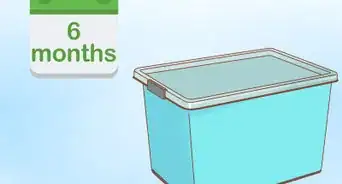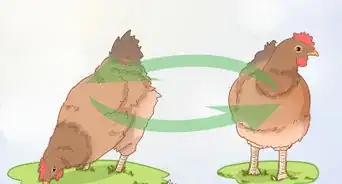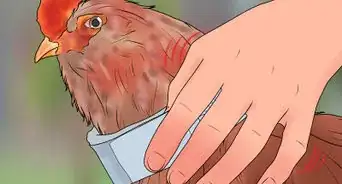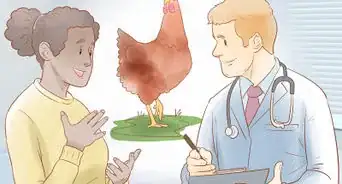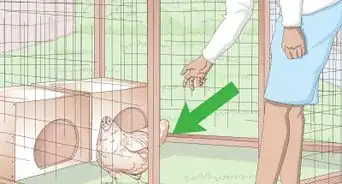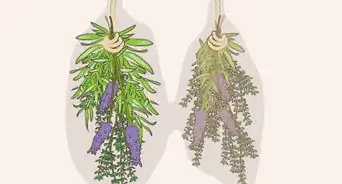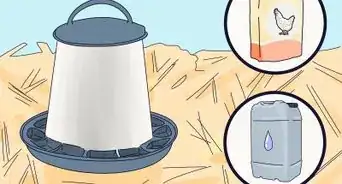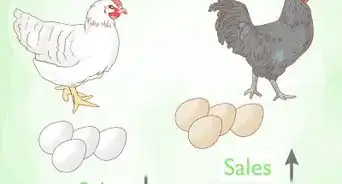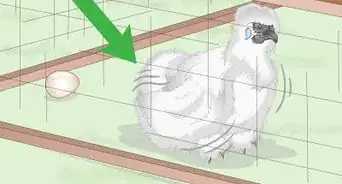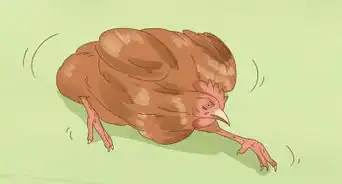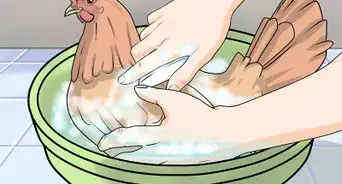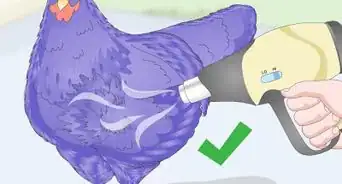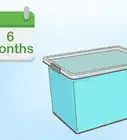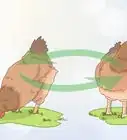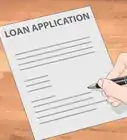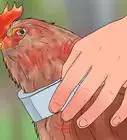This article was co-authored by wikiHow Staff. Our trained team of editors and researchers validate articles for accuracy and comprehensiveness. wikiHow's Content Management Team carefully monitors the work from our editorial staff to ensure that each article is backed by trusted research and meets our high quality standards.
There are 8 references cited in this article, which can be found at the bottom of the page.
The wikiHow Video Team also followed the article's instructions and verified that they work.
This article has been viewed 36,461 times.
Learn more...
Chicken feeders come in many different types, including no-waste, automatic, and trough feeders. A pre-made chicken feeder can be expensive, but you can save money by making your own chicken feeder. Make a simple feeder using buckets and PVC pipes, or create a trough feeder with different length pipes and an elbow pipe joint.
Steps
Making a Simple No-Waste Feeder
-
1Cut a 2 in (5.1 cm) section out of the end of a 3 ft (0.91 m) PVC pipe. Measure from the end of the pipe and make a mark on it about 2 in (5.1 cm) in. Then, use a hand saw or power saw to cut about halfway through the pipe at this point. After that, make 2 more cuts going inwards from the end of the pipe. This will remove a 2 in (5.1 cm) wide square section from the end of the pipe.[1]
- Do not cut out any other sections out of the pipe!
- Do not cut all the way through the pipe. Only cut halfway through it on 1 end.
Warning: Using a hand saw can be dangerous! Hold the pipe steady and cut the pipe on a sturdy surface, such as a work bench. Also, wear goggles to protect your eyes from any debris that comes off the pipe as you saw.
-
2Glue the back of the pipe to the inside of a shallow bucket. Apply a generous amount of liquid cement or another strong adhesive to the uncut, back side of the pipe. Then, insert the end of the pipe into the bucket. Press the adhesive side against the inside of the bucket. Hold it in this position for about 1 minute to let the adhesive bond.[2]
- Use a bucket that is around 6 in (15 cm) in height. This will ensure that the chickens can reach the food with ease.
Advertisement -
3Lay the feeder on its side and allow the glue to dry overnight. Lay the pipe and bucket on the ground. Keep the pipe in the position you glued it in. Make sure it presses against the inside of bucket as it dries. It may only take about 15 minutes for the liquid cement to dry fully, but leave it for at least 1 hour to be sure.[3]
- Liquid cement starts to dry quickly, so press the bucket and pipe together right away.
-
4Pour food into the top of the pipe and allow the chickens to feed freely. After the pipe has dried completely, pour chicken feed into the tube to fill it. Hold the pipe upright as you fill it. The feed will spill out into the bucket and this will keep the feeder erect after it is full.[4]
- Don’t worry about the bucket overflowing. The feeder will only allow food to come out as high as the section you cut in the pipe, so there should be no more than 2 in (5.1 cm) of feed in the bucket at all times.
- You may want to tie the filled feeder to a post to help keep it steady. It will stand upright on its own, but it may still tip over if it gets bumped.
Creating a Pipe Trough Feeder
-
1Cut 4 holes in the center of a 1.5 ft (0.46 m) PVC plastic pipe. Choose a PVC pipe that is about 4 in (10 cm) in diameter. Use a drill with a hole cutting bit to cut 2 in (5.1 cm) diameter holes in 1 side of the pipe.[5]
- If you do not have a drill with a hole cutting bit, use a hand saw or power saw to cut a 6 in (15 cm) section out of the center of the pipe. Do not cut all the way through the pipe. Only cut a 6 in (15 cm) section that goes halfway through the pipe.
Warning: Be very careful when using power tools! Hold the pipe steady on a sturdy surface, such as a work bench or table. Also, make sure to wear protective eyewear as you drill or saw the pipe.
-
2Attach an elbow pipe piece and a 3 ft (0.91 m) PVC pipe. Place an elbow piece on 1 end of the 1.5 ft (0.46 m) pipe. Then, connect the 3 ft (0.91 m) PVC pipe to the other end of the elbow. Adjust the elbow and pipes so that they form a right angle.[6]
- Make sure that the holes or section you cut out of the pipe are facing upwards.
-
3Place a cap on the open end of the shorter PVC pipe. To prevent chicken feed from spilling out, place an end cap onto the other end of the 1.5 ft (0.46 m) pipe. If the lid does not fit tightly, apply liquid cement or another strong adhesive to the inside of the cap to help it stay in place.[7]
- Make sure that you let the adhesive on the end cap dry completely before using the feeder. This should only take about 15 to 30 minutes, but wait at least 1 hour to ensure that they are dry.[8]
-
4Pour food into the opening of the vertical pipe to feed your chickens. Position the feeder so that the upright tube is in a corner to stabilize it. Then, with the open end of the 3 ft (0.91 m) pipe pointing up, pour chicken feed into the feeder. Keep filling until the feed reaches the top of the 3 ft (0.91 m) pipe. Then, place an end cap on the pipe to protect the food from moisture.[9]
- Do not glue this end cap in place since you will need to remove it each time you feed your chickens.
Warnings
- Be cautious when using a power drill or saw!⧼thumbs_response⧽
Things You'll Need
Making a Simple Pipe and Bucket Feeder
- 3 ft (0.91 m) PVC pipe
- Ruler or measuring tape
- Hand saw
- 6 in (15 cm) high bucket
- Liquid cement
Creating a Pipe Trough Feeder
- 3 ft (0.91 m) PVC pipe
- 1.5 ft (0.46 m) PVC pipe
- 2 end caps
- Elbow joint
- Hole cutting drill bit and drill or hand saw
- Liquid cement (optional)
References
- ↑ https://www.youtube.com/watch?v=8KAqFcwdlEs&feature=youtu.be&t=153
- ↑ https://www.youtube.com/watch?v=8KAqFcwdlEs&feature=youtu.be&t=173
- ↑ https://www.hunker.com/12000141/what-is-the-cure-time-for-pvc-cement
- ↑ https://www.youtube.com/watch?v=8KAqFcwdlEs&feature=youtu.be&t=180
- ↑ https://www.youtube.com/watch?v=8KAqFcwdlEs&feature=youtu.be&t=34
- ↑ https://www.youtube.com/watch?v=8KAqFcwdlEs&feature=youtu.be&t=67
- ↑ https://www.youtube.com/watch?v=8KAqFcwdlEs&feature=youtu.be&t=61
- ↑ https://www.hunker.com/12000141/what-is-the-cure-time-for-pvc-cement
- ↑ https://www.youtube.com/watch?v=8KAqFcwdlEs&feature=youtu.be&t=94
About This Article
To make a simple no-waste chicken feeder, start by cutting a square, 2-inch section out of the end of a 3-foot long PVC pipe. Next, use rubber cement to glue the uncut side of the pipe to the inside of a shallow bucket, with the opening you cut positioned at the bottom of the bucket and facing out. Once the pipe is glued in place, lay the bucket on its side and allow the glue to cure for at least an hour. When the glue is completely dry, pour chicken feed into the tube and let it flow out into the bucket. To learn how to make a pipe trough feeder, read on!

